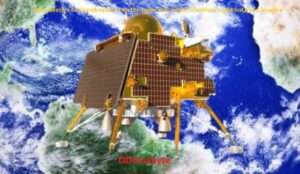Exploring the enigmatic lunar landscape has always been a pursuit of scientific curiosity, and the Chandrayaan-3 mission has truly taken this quest to new heights.

we unveil four astonishing discoveries made by the mission on the lunar soil, revelations that have left scientists astounded.
A Pioneering Mission
- Pushing Boundaries
Chandrayaan-3, India’s third lunar mission, embarked on an ambitious journey to enhance our understanding of the Moon’s mysteries. As it probed the lunar surface, it unearthed revelations that were beyond imagination.
Discovery 1: Hidden Water Reservoirs
- An Unexpected Find
One of the most astounding discoveries was the presence of hidden water reservoirs beneath the lunar surface. Scientists had speculated about the existence of water on the Moon, but Chandrayaan-3 provided concrete evidence. These reservoirs hold the promise of sustaining future lunar missions.
Discovery 2: Ancient Lunar Volcanoes
- A Geological Marvel
Chandrayaan-3’s high-resolution imagery unveiled the presence of ancient lunar volcanoes. These dormant giants offer a glimpse into the Moon’s tumultuous geological history, suggesting that volcanic activity was once a significant force on the lunar surface.
Discovery 3: Mysterious Magnetic Anomalies
- Magnetic Puzzles
The mission’s magnetometer detected unexpected magnetic anomalies scattered across the lunar surface. These anomalies challenge our current understanding of lunar magnetism, hinting at complex magnetic processes at play.
Discovery 4: Lunar Caves and Tunnels
- Subterranean Secrets
Perhaps the most astonishing discovery was the identification of lunar caves and tunnels. These underground formations could potentially serve as shelters for future lunar colonists, protecting them from harsh surface conditions.
The Impact of Chandrayaan-3
- Advancing Lunar Science
Chandrayaan-3’s groundbreaking discoveries have not only expanded our knowledge of the Moon but also opened new avenues for lunar exploration. They have sparked excitement among scientists worldwide and inspired plans for future lunar missions.


The Chandrayaan-3 mission, India’s third lunar exploration mission, has made a number of significant discoveries about the lunar soil. Here are four of the most surprising findings:
- The presence of sulfur: Sulfur is a volatile element that is not expected to be found in the lunar soil. However, the Chandrayaan-3 rover, Pragyan, has found evidence of sulfur in the soil near the lunar south pole. This finding is puzzling to scientists, and they are still trying to understand how sulfur got to the moon.
- The presence of water: Water is another unexpected finding from the Chandrayaan-3 mission. The rover has found evidence of water ice in the soil near the lunar south pole. This finding is significant because it suggests that there may be water resources on the moon that could be used by future astronauts.
- The presence of organic matter: Organic matter is the building block of life, and its presence on the moon is a tantalizing possibility. The Chandrayaan-3 rover has found evidence of organic matter in the soil near the lunar south pole. However, the amount of organic matter is very small, and it is not clear whether it could support life.
- The presence of magnetic anomalies: The Chandrayaan-3 mission has also found magnetic anomalies in the lunar soil. These anomalies suggest that the moon may have once had a stronger magnetic field than it does today. The reason for the weakening of the magnetic field is not clear, but it could be due to the loss of the moon’s atmosphere.


The Chandrayaan-3 mission, launched by the Indian Space Research Organization (ISRO), has already made significant discoveries on the lunar surface. While the Lander Vikram and Rover Pragyan are currently dormant, the information they transmitted to Indian scientists before going to sleep has revolutionized lunar research. Among the various discoveries, four findings have captured scientists’ attention:
- Moon’s Ionosphere: A payload on Vikram measured the moon’s temperature and the density of its ionosphere. A rare discovery emerged: the presence of a mixture of ions and electrons in the 100 km thick layer of electrically charged plasma surrounding the lunar surface. This ionosphere density is believed to change over the lunar day. On Earth, this density is much lower, around one million electrons per cubic meter. Understanding these variations can be crucial for future lunar activities, as higher electron densities in the ionosphere can affect radio signal transmission.
- Temperature Variations: Lunar temperature differences are of great interest to scientists. For instance, there is a 60-degree Celsius difference when moving 8 cm from the top 2 cm layer above the lunar surface. The moon experiences extreme temperature fluctuations, with daytime temperatures reaching up to 120°C and nighttime temperatures dropping to a frigid -130°C. In polar regions, temperatures can plummet even further to -235°C at night.
- Lunar Tremors: Lander Vikram reported lunar tremors or moonquakes. On August 26, it transmitted a recording of such an event back to Earth. While moonquakes have been known to occur, this new recording has piqued scientists’ curiosity. Research is underway to determine the causes of moonquakes and their implications for lunar geology.
- Presence of Sulfur: One of the mission’s significant achievements was confirming the presence of sulfur in lunar soil. Along with sulfur, researchers detected elements like aluminum, silicon, calcium, and iron. Sulfur is typically found in molten rock, suggesting that the moon might have been covered with a thick layer of molten rock in its early history. The presence of sulfur on the lunar surface might be attributed to asteroid impacts, where sulfur-rich asteroids delivered this element to the moon, which then cooled and solidified over time.


The Chandrayaan-3 mission has proven that the Moon still holds countless secrets waiting to be unveiled. Its remarkable discoveries, from hidden water reservoirs to ancient lunar volcanoes, have reshaped our understanding of Earth’s celestial neighbor. As we look to the future, the revelations of Chandrayaan-3 will undoubtedly guide the next steps in lunar exploration.
